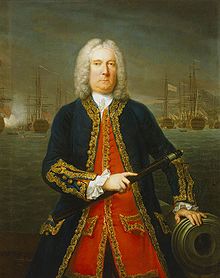Thomas Mathews
| Thomas Mathews | |
|---|---|

Admiral Thomas Mathews, 1743, by Claude Arnulphy.
|
|
| Born | October 1676 Llandaff Court, Llandaff |
| Died | 2 October 1751 (aged 74–75) Bloomsbury Square, London |
| Allegiance |
|
| Service/branch |
|
| Years of service | 1690–1747 |
| Rank | Admiral |
| Commands held |
HMS Yarmouth HMS Kingsale HMS Gloucester HMS Chester HMS Prince Frederick HMS Kent |
| Battles/wars |
|
Thomas Mathews (October 1676 – 2 October 1751) was a British officer of the Royal Navy, who rose to the rank of admiral.
Mathews joined the navy in 1690 and saw service on a number of ships, including during the Nine Years' War and the War of the Spanish Succession. He interspersed periods spent commanding ships with time at home at the family estate in Llandaff. He distinguished himself with service with Sir George Byng at the Battle of Cape Passaro in 1718, and went on to command squadrons in the Mediterranean and Indian Ocean, before largely retiring from naval service. He returned to active service in 1741, following Britain's entry to the War of the Austrian Succession, and took command of the fleet in the Mediterranean. The usual difficulties of performing delicate diplomatic duties were further exacerbated by the fact that he was on bad terms with his second in command, , on whom he relied to manage the fleet. The pivotal moment of his naval career came in 1744, when he attempted to intercept a Franco-Spanish fleet at the Battle of Toulon. The action was fought in confused circumstances, with poor communications and the breakdown of the chain of command. Despite possessing the superior force, Mathews was unable to secure a decisive result, and the enemy were able to escape with the loss of one ship, while Mathews's fleet lost one and had several others badly damaged.
The failure to secure a victory incensed the British public, and a series of courts-martial and a public inquiry led to several officers being cashiered. Mathews' second in command, Lestock, was tried but acquitted, blaming the outcome on Mathews' poor planning and ill-tempered and unwise attack. Mathews was tried and convicted of the charges, and dismissed from the navy. He returned to his estates at Llandaff, before moving to London and dying there in 1751.
He was born at Llandaff Court, Llandaff, the son of Colonel Edward Mathews (died 1700), and grandson on his mother's side of Sir Thomas Armstrong (1624–1684) (who was executed in 1684, for his part in the Rye House Plot). Mathews was also a descendant of the Welsh knight Sir David ap Mathew and King Louis VI of France. Mathews joined the navy in 1690, serving aboard HMS Albemarle, which was then under the command of his uncle, Sir Francis Wheler. Mathews served during the Nine Years' War, and may have been present at the Battle of Beachy Head, and was likely in action at the Battle of Barfleur. Mathews went on to serve aboard HMS Portland under Captain James Littleton in 1697, and on 31 October 1699 Vice-Admiral Matthew Aylmer appointed him lieutenant aboard his flagship, HMS Boyne. Mathews served with Aylmer in the Mediterranean, before being moved to HMS Deale Castle in 1700. Mathews went on to serve with John Graydon in the West Indies, being promoted by him to command HMS Yarmouth, a position he took up on 24 May 1703.
...
Wikipedia
